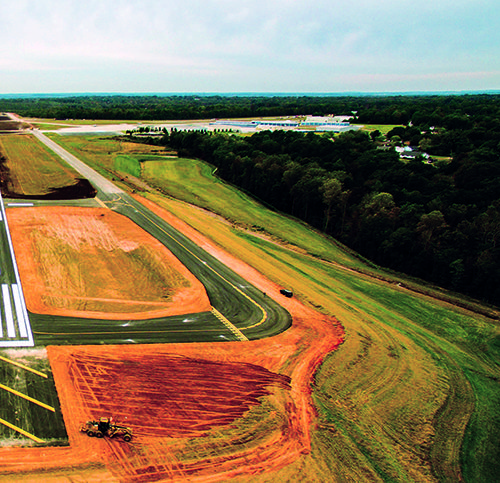South Carolina’s historic Spartanburg Downtown Memorial Airport (SPA) has undergone an extreme makeover of sorts in the last seven years to enhance its economic development role and help it better compete with neighboring airports. The multi-project effort was capped by a $30 million runway rehabilitation and extension that opened in October 2018.
South Carolina’s historic Spartanburg Downtown Memorial Airport (SPA) has undergone an extreme makeover of sorts in the last seven years to enhance its economic development role and help it better compete with neighboring airports. The multi-project effort was capped by a $30 million runway rehabilitation and extension that opened in October 2018.
 Other major improvements at the city-owned general aviation airport include a new navigation system and runway lights, added during the recent runway extension; a city-funded playground and park, completed last spring; and renovation of the airport’s 81-year-old Art Deco terminal building, coupled with a reconfigured and expanded parking lot. The $4.4 million terminal project, completed in 2011 and also funded by the city, included two new units of T hangars.
Other major improvements at the city-owned general aviation airport include a new navigation system and runway lights, added during the recent runway extension; a city-funded playground and park, completed last spring; and renovation of the airport’s 81-year-old Art Deco terminal building, coupled with a reconfigured and expanded parking lot. The $4.4 million terminal project, completed in 2011 and also funded by the city, included two new units of T hangars.
“The runway and the terminal were in pretty bad shape,” recalls Terry Connorton, SPA director since December 2017. But recent improvements help position the growing airport to better serve a business boom in Upstate South Carolina, home to major companies like BMW Manufacturing Corp., GE Power, Michelin North America, Lowes, Home Depot and Milliken & Co.
|
facts&figures Projects: Runway Expansion; Public Park; Terminal Renovation Location: Spartanburg (SC) Memorial Downtown Airport Est. Annual Operations: 33,000 Runway Cost: $30 million Runway Funding: 90% FAA; 5% state; 5% city
New Runway Length: 5,852 ft. Construction: 2016 to late 2018 Runway Closure: 4 months in 2018 Engineering/Project Management: W. K. Dickson Instrument Landing System: Thales Group PAPI Lights: NBP Corp. Terminal Renovation Cost: $4.4 million Renovation Funding: City of Spartanburg Airport Park Cost: $975,000 Park Funding: City of Spartanburg Key Benefits: Increased safety; new capabilities for larger corporate aircraft; ability to accept overflow traffic from other regional airports as business activity increases; expected revenue increases |
“There’s a lot of Upstate growth right now,” Connorton explains. “The city of Spartanburg also has been undergoing dramatic growth for the last several years. There are more people and businesses moving east, toward us, so we’re starting to pick up a lot of overflow air traffic—planes that typically go to GSP (Greenville-Spartanburg International Airport).
“We’re right in the crosshairs of I-26 and I-85, so our expansion helps us take advantage of all this economic growth. We’re in a good location to take on more business.”
The airport’s series of landside and airside improvements are designed to help it compete with other regional airports. Aside from GSP, the city-owned airport vies for traffic with five other general aviation facilities: Greenville Downtown Airport, Donaldson Center Airport and three small county airports. About 80% of SPA’s operations are business related, while recreational traffic accounts for most of the remainder.
Currently, SPA handles nearly 33,000 operations annually and is estimated to generate $41.8 million annual impact on the local economy.
Accommodating Larger Planes
The $30 million runway project, which involved resurfacing the airport’s sole runway and extending it by 650 feet, represents the most significant improvement. The FAA paid 90% of the cost; the state and city chipped in 5% each.
Now 5,852 feet long with a new navigation system, Runway 5-23 makes the airport more attractive to companies with larger corporate jets, such as Gulfstream 550s—a boon to business prospects. “A lot of planes still can get in and out on shorter runways; but to do so, they can’t carry as much fuel,” Connorton explains. “So with the longer runway, business jets can fly longer distances without having to stop. They don’t want to stop and refuel because it costs money and time.”
The runway project was executed in three phases. Phase one started in 2016 and was completed in mid-2017. It centered on moving 1.7 million cubic yards of soil and filling in a small pond that sat in the path of the runway extension.
Phase two started in mid 2018 and focused on resurfacing the existing runway and building the extension. “We had considered closing just half of the runway down, but decided to rip off the Band-Aid,bite the bullet and close it completely to get it done faster,” Connorton remarks.

The closure was supposed to last two months, ending in August, with all air traffic diverted to other local airports in the meantime. But the closure instead lasted into four months, courtesy of Hurricane Florence in September and Hurricane Michael in October. “It rained a lot…so we ended up with an Olympic-size swimming pool—a 6,000-foot-long ditch filled with water,” Connorton recalls. “As a result, we spent a lot of time digging drainage ditches.”
The runway opened in late October. During the phase of the project, crews installed a new navigation system (precision approach path indicator, or PAPI, lights) at each end of the runway. The airport is also installing an upgraded instrument landing system, scheduled for completion later this year.
Playground & Park
While the runway project provides improvements for customers, a $975,000 park funded by the city is helping raise public awareness about the airport.

Built on property vacated by the Civil Air Patrol, the seven-acre park features two playground areas with aviation-themed equipment, a multipurpose athletic field, a splash pad, fitness equipment, two pavilion shelters, picnic tables, restrooms facilities and a paved walking path.
“It’s a very popular place,” Connorton reports. “It brings a lot of people over (to the city’s west side), and they realize there’s actually an airport here. A lot of people see airplanes around here, but they think they’re going to Greenville-Spartanburg, even though they’re actually landing here. It’s a real shot in the arm for the airport in terms of people coming out and realizing there’s an airport here.”
Visitors may not realize it, but the playground and adjoining pathways are positioned to replicate the airport’s original layout in 1927. “From up above, you can see how the original runways were laid out,” Connorton says. “There’s a tall slide that stands where the control tower was, plus the swings are airplanes and the walkways feature runway markings.”
The new aviation-themed park helps fulfill one of Connorton’s goals: making sure the general public understands SPA’s rich history. For example, Charles Lindbergh visited the airport in 1927, during a nationwide tour following his historic solo flight across the Atlantic Ocean. At the time, SPA was the state’s first and only commercial airport. In 1931, Amelia Earhart became another famous fly-in visitor; and the airport provided the state’s first airmail service.
Cultivating Goodwill
The park helps achieve another of Connorton’s ongoing goals: improving community outreach. Toward that end, he established the Spartanburg Aviation Community Program, which gives local schools the opportunity to use the airport as a classroom. “It enables local educators to see if any students might be interested in pursuing aviation careers,” says Connorton. “And the park helps promote that, because people who go there can see planes landing and taking off.”

The program exposes students to a variety of aviation careers. They can attend an educational class sponsored by the Civil Air Patrol, use a flight simulator, attend a session about glider flight, see how planes are refueled and serviced, work on an airplane with an aviation mechanic and take a short plane ride to another local airport for lunch.
“You can’t put a monetary value on it, but for a local airport to survive, you have to have goodwill from the city and its residents,” he explains. “Otherwise, they think the airport is just for rich people…they only focus on the noise and don’t see its greater value. And the park plays a small role
in that.”
Connorton also teaches free ground school classes on weekends for young people and visits local schools to talk about aviation. Doing so, he hopes to create some goodwill beyond existing airplane owners and pilots.
“When people can see the value of an airport and how it supports the city by bringing in business and creating jobs, it all adds up,” he explains. “They need to understand that airports create a ripple effect in terms of economic impact. The airport employs workers that refuel aircraft. Visitors fly here and rent cars, stay in hotels, rent conference rooms and eat meals at restaurants. The airport creates a huge impact, and we want to keep playing a vital role in the area’s economic growth.”



